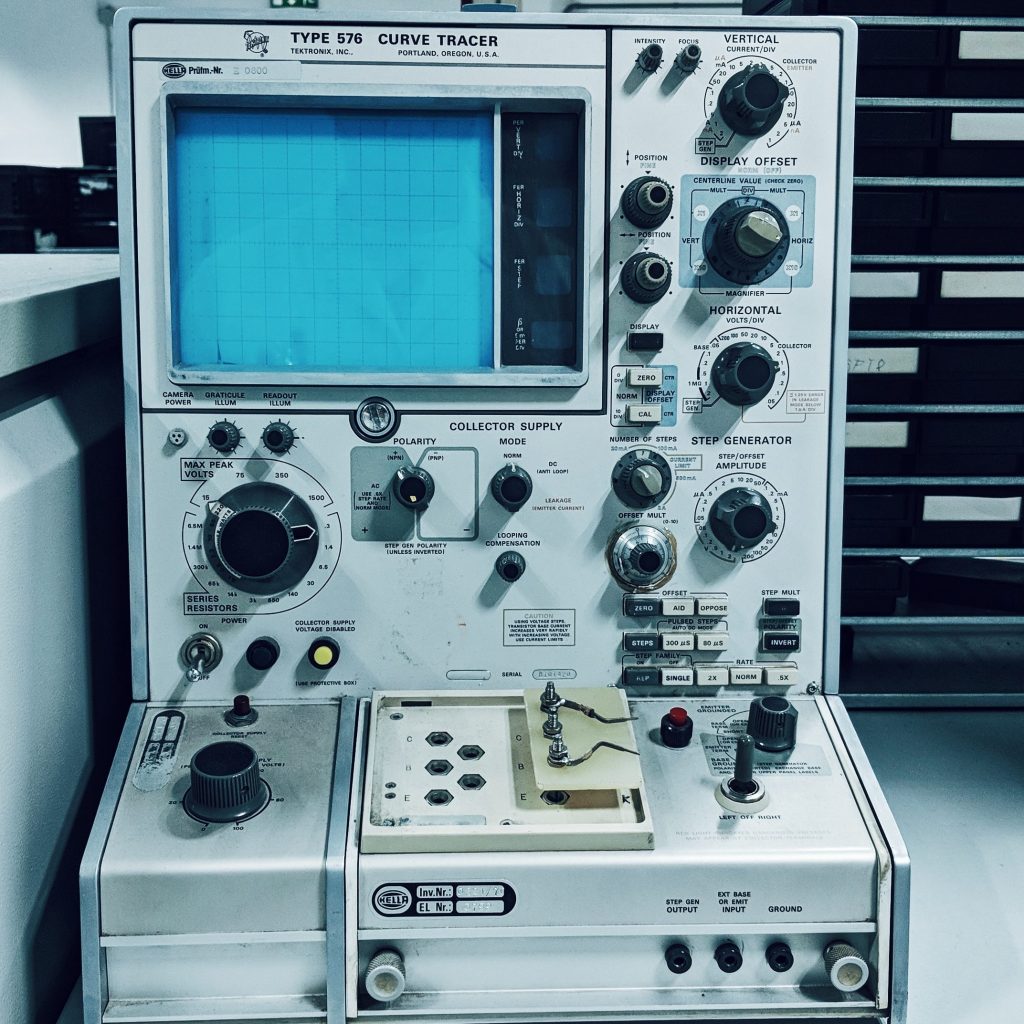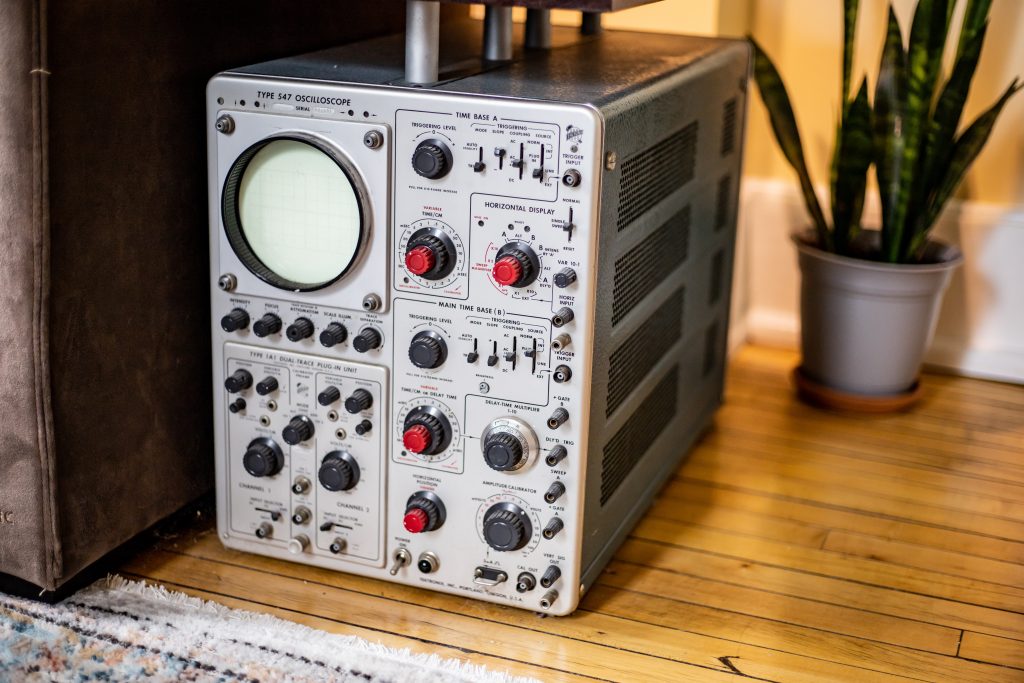Founded in 1946, Tektronix has become an innovative leader in the test equipment industry. A well-known source of technical tools for scientists and engineers alike, Tektronix has helped develop industries from medical field to space exploration. With technological advancements happening nearly every day, it’s worth looking back at the innovative hardware that led us to where we are. This blog post will look at a few of the most notable oscilloscopes from Tektronix history.
1947- Oscilloscope Model 511
The 511 was the very first oscilloscope from Tektronix, following their unsuccessful first product, the Type 101 Video Calibrator. Despite the failure of its predecessor, the 511 was a success. In fact, it was so well received that the then modestly sized manufacturing facility had lead times that stretched on for months!
The 511 was built for applications at medium and high frequencies, and it couldn’t handle frequencies below 60 Hz. Lack of vertical gain, inability to observe the trigger component of the waveform, and lack of voltage control were among the other flaws. The device was named the “511” because it had a 5 inch tube, 1 channel, and was the first model. It weighed 65 pounds, and cost $795 dollars upon its release.
1954- Oscilloscope Model 535
The Tektronix Model 535 was unveiled in 1954, and it was sold for over 2 decades. The 535 incorporated a cathode ray tube (CRT) that was designed and manufactured in-house. The external trigger inputs of this oscilloscope began as UHF connections, and were later changed to BNC connections in the early 60s. Originally, the oscilloscope came in a brown case that slid out to open. By the end of its run, it came in a blue case with sides that popped off to open.
1956- Oscilloscope Model 545
In 1956, Tektronix unveiled the 545, which was an oscilloscope with dual timebases that allowed for delayed triggering. The 545 model had a scope of 30 MHz, and a modular plugin capability that worked with both letter and 1-series plug-ins. Upon the time of its release, the 545 was one of the premier scopes of Tektronix’s 540 series line. The oscilloscope was later replaced with two distinct versions: the 545A, which utilized the T5430 CR, and the 545B, which utilized the T5470 CRT.

1964- Oscilloscope Model 564
1964 brought a new breakthrough of scope technology for Tektronix, in the form of the 564 model. The 564 was a storage oscilloscope, and one of the first of its kind- it was one of the first commercially available storage scopes in the world. Produced by Tektronix until 1968, the scope used plugins from the Tek-2 and Tek-3 series. The bandwidth was restricted to about 300 KHz, but had a storage time of at least an hour.
In 1969, the updated 564B model was released. As opposed to the cathode ray tube base of the original 564 model, the 564B was completely solid state.
1971- The Digital Oscilloscope
The creation of the Digital Oscilloscope was a monumental event in scope history, forever changing the trajectory of oscilloscope innovation. One of the pioneering engineers was Hiro Moriyasu, who worked for Tektronix for more than 25 years after first joining the company in 1959. Moriyasu’s work on the digital oscilloscope and additional computer technology innovations eventually led to him becoming Tektronix’s general manager of scientific graphic computers.
1994- The TLS216 Logic Scope
Jumping ahead from the early 1970s to the mid 1990s, the Tektronix TLS216 Logic Scope is an excellent tool for examining and troubleshooting digital circuits. The TLS216 meets the demands of digital designers and troubleshooters alike, with total documentation and measurement capabilities. This model allows for 5 different kinds of triggers; edge, pulse, pattern, state, and sequence. The straightforward operation of the TLS216 utilizes visual symbols and familiar knobs.
The technical specifications of the TLS216 include a maximum bandwidth of 500 MHz, and a 2 Gigasamples/second max digitizing rate.
1998- Digital Phosphor Oscilloscope (DPO)
The Digital Phosphor Oscilloscope was invented by Tektronix in 1998. This new type of oscilloscope transformed the industry by giving engineers a tool for recording and studying electrical signals with improved viewing capabilities.
Digital Phosphor Oscilloscopes offer enhanced visualization of signals, faster update rates, color grading, advanced triggering, deeper memory storage, and remote connectivity capabilities.

2009- MSO70000
In the early 2000s, Tektronix released the MSO70000 Mixed-Signal Oscilloscope. Mixed Signal Oscilloscopes are designed to combine the capabilities of traditional oscilloscopes with logic analyzers, allowing engineers to visualize and analyze both analog and digital signals simultaneously. The MSO7000 has 16 digital channels and 4 analog channels, featuring up to 20 GHz of bandwidth. Additionally, the scope features a sample rate of 50 GS/s.
2020- TekDrive
While the final entry on our list is software and not a physical oscilloscope, it is a fairly recent innovation that is notably changing the tech landscape of oscilloscope storage and file sharing.
TekDrive uses a collaborative workspace that allows users to upload, organize, download, or share any type of file from a connected device. Since it’s creation, TekDrive has been included directly on several scope types. It features convenient cloud storage to handle data, increased privacy for secure sharing, tools for data management. TekDrive allows multiple instruments to integrate with ease, allowing for real-time collaboration.
Additional Information: